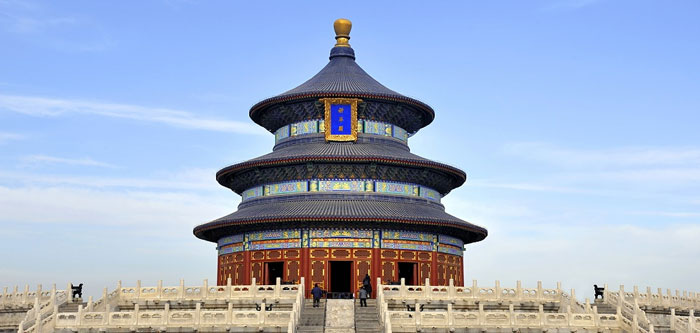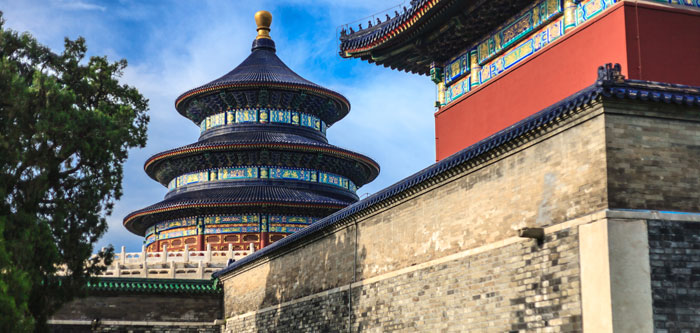Temple of Heaven - The Largest Imperial Sacrificial Altar
The Temple of Heaven is the largest imperial sacrificial altar in the world and covers 2,730,000 square meters. Because of its marvelous design and layout, it is regarded as "a masterpiece of architecture and landscape design". Some people even believe that it is more luxurious and delicate than the Forbidden City. It originally served as an imperial sacrificial altar. During every winter solstice, the emperor held a splendid ceremony to pray for a good harvest and redemption.
What's Different About the Temple of Heaven
- Discover the beliefs of the ancient Chinese people by visiting the Temple of Heaven where the emperor prayed for a good harvest and sought divine atonement.
- Admire a representative Chinese-style architectural masterpiece, which was constructed in accordance with a traditional theory: symmetry, axial arrangement, luxurious decoration, and Confucian thoughts.
- Discover the amazing ancient Chinese culture: delicate carving work, a marvelous layout design, and numerous exquisite Chinese-style decorations.
Highlights of the Temple of Heaven
The Temple of Heaven Was Greatly Affected by Zhou Yi
Layout The layout of the Temple of Heaven was in accordance with the "Eight Diagrams", which were from a famous classic book — Zhou Yi (it displayed ancient Chinese history, culture, and philosophy well). The Temple of Heaven was a holy place used to make sacrifices to the gods. It is located in the southern part of Old Beijing. In ancient times, south was regarded as an honorable direction because it is closer to the sun. The ceremonies of sacrificing to the sun and moon were also affected by Zhou Yi.
 The Temple of Heaven
The Temple of HeavenThere is a famous theory of Zhou Yi: man is an integral part of nature. Therefore, reverence for nature was the most basic belief of the ancient Chinese people. Building Appearance Zhou Yi stated that 'qian' (one of the Eight Diagrams) represented heaven and that heaven is round. As an altar for sacrificing to heaven, the Temple of Heaven was designed as a circle. This belief was also incorporated into other sections: the Circular Mound Altar, the Imperial Vault of Heaven, Echo Wall, the top of the Hall of Prayer for Good Harvests, and the peripheral walls. Therefore, circles are an outstanding feature within the Temple of Heaven.
Top Attractions at the Temple of Heaven
The Temple of Heaven is the largest sacrificial complex in the world, and it can be divided into two parts: the Inner Altar and the Outer Altar. Most of the buildings are focused on the Inner Altar's south-north axis, such as the Circular Mound Altar, the Imperial Vault of Heaven, and the Altar of Prayer for Grain.
Circular Mound Altar
The Circular Mound Altar is a three-layer stage and is 5.17 meters high. It is the most important altar in the Temple of Heaven and was used to offer sacrifices to heaven. Nine is a holy number for God and this altar used it widely: there are nine stairs leading to the top of it, the outer circle consists of nine stones, and the inner circle also consists of nine stones. When the winter solstice arrived, the emperor would hold a ceremony to sacrifice to heaven at the Circular Mound Altar. 
Imperial Vault of Heaven
The Imperial Vault of Heaven is a circular architectural structure containing tablets of the emperors' ancestors. The dougong (a system of brackets inserted between the top of a column and a crossbeam) and the span of the caisson ceiling are the only ones in the history of Chinese architecture. The hall is decorated by abundant and exquisite paintings of dragons and the phoenix (divine animals in ancient Chinese legends). A marble stone comprises its base and there are 16 pillars supporting the Imperial Vault of Heaven. The shape of it echoes the lines of the Hall of Prayer for Good Harvests.
Echo Wall
Echo Wall is located in the north part of the Circular Mound Altar and was built in 1530. It is a smooth, circular, 3.72-meter-high wall surrounding the Imperial Vault of Heaven.The reflection of sound waves is very regular due to the smoothness and shape of the wall. As long as two people are standing in the east and west halls, and one person is leaning against the wall to speak toward the north, sound waves will reflect along the wall continuously. It is an interesting and mysterious wall. Different from other holy and quiet sections in the Temple of Heaven, visitors offer cries instead of sacrifices, hoping to hear their voices bounce back to them.
Hall of Prayer for Good Harvests
The Hall of Prayer for Good Harvests is an ornate circular building built on a marble stone base. It is a landmark architectural structure within the Temple of Heaven. It is 38 meters tall and consists of 28 immense silkwood pillars without nails. There are four pillars in the middle of the hall named the "Longjing Pillars", which represent the four seasons in a year. Twelve pillars in the middle level of the hall are named the "God Pillars" and represent the 12 months in a year. The 12 pillars that comprise the outer layer are named the "Yan Pillars" and represent 12 shichen (one shichen equals 2 hours). The 24 pillars that comprise the middle and outer sections combine to represent the 24 solar terms. The name alone evidently implies that it is a hall of prayer for good harvests.
The Hall of Abstinence
The Hall of Abstinence is located in the western section of the Temple of Heaven and covers almost 40,000 square meters. It consists of three main structures: a bell tower, two stone pavilions, and a beamless hall. Before each ceremony, the emperor would hold a 3-day fast in the Hall of Abstinence to show his respect to the gods and the importance of offering sacrifices to heaven. During the 3 days, he couldn't drink wine, eat meat, have any entertainment, handle state affairs, or get close to women.
Sacrificial Rites
Worshiping heaven was an important part of the ancient Chinese people's lives and it became a cultural behavior to pray to the gods to bless them. These holy sacrificial rites have a history of 5,000 years since the legendary epoch of the "Three Emperors and Five Sovereigns". There were 22 emperors in total who held ceremonies to worship heaven in the Temple of Heaven until the 1911 revolution overthrew the Qing Dynasty (1644–1912). In the history of China, worshiping heaven wasn't just a feudal rite but an irreplaceable part of culture and faith for the ancient Chinese people. 
Travel Tips for the Temple of Heaven
- Chinese: 天坛 Tiāntán / tyen-tan
- Location: Doncheng District, Beijing; 3.4 kilometers from Tian'anmen Square
- Area: 2,730,000 square meters (273 hectares)
- Ticket: 15 yuan
- Visiting hours: about 3–4 hours
- Opening times: 8am to 5:30pm
- Best seasons: The temperate continental climate in spring (April and May) and autumn (September and October) is pleasant; the temperature range is from 10°C to 20°C (50°F to 68°F).
Transportation
The Temple of Heaven is located to the south of Tian'anmen Square and is about 4 kilometers away from it. You can get there easily. By Bus
- Take bus 36, 120, or 122. Get off at the Temple of Heaven Station's South Gate.
- Take bus 2 or 120. Get off at the Temple of Heaven Station's West Gate.
- Take bus 6, 34, 35, 36, 106, or 111. Get off at the Temple of Heaven Station's North Gate.
- Take bus 25, 34, 35, 36, 39, 41, 43, 60, 610, 684, 685, 723, or 814. Get off at the Temple of Heaven Station's East Gate.
By Subway Take subway line 5 and get off at the Temple of Heaven Station's East Gate.
Hire a Guide
The Temple of Heaven is not only a splendid architectural structure but also has a perfect blend of Chinese history and culture. Hiring a guide is essential for history enthusiasts. E-Guide Location: within the area of the four gates Time: 8am to 5pm Language: English, French, Japanese, Spanish, German, Korean, Chinese, and Cantonese Tour Team Guide Location: South Gate at the Temple of Heaven Time: 8am to 5pm Language: English and Chinese Cost: 150 yuan for fewer than five people; 250 yuan for more than five people Note: The price is for a group not per person. You need to book the team guide 2 days before the tour.



